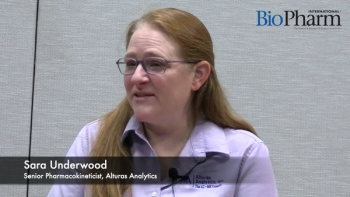
Funding in Early-Stage Biotech and the Promise of siRNA
As part of our 2025
Hoekman noted that “siRNA… is at a point where it has real potential to broaden out, to treat many different illnesses.” He pointed to the advantages of siRNA therapies, including infrequent dosing schedules, ranging from monthly to yearly, and relatively lower production costs compared with biologics. He also highlighted the growing interest in targeting genes both within and outside the liver, reflecting an expansion of siRNA applications beyond initial liver-focused treatments.
The discussion also addressed challenges in the current funding environment for early-stage biotech companies. Hoekman described the difficulties in raising capital due to limited public market activity and a reduced appetite among venture capitalists for early-stage investments. He observed that this tightening has led companies to focus more on cost efficiency and clear evidence of clinical value.
Hoekman also suggested that collaboration may be necessary in this environment, whether through partnerships with pharmaceutical companies or mergers between smaller biotech firms. He said, “There’s only so many pharmaceutical companies and they have limited resources as well. However, they tend to have a longer-term view,” indicating that aligning with established players might be critical for smaller companies facing capital constraints. This reflects a cautious approach to drug development amid a complex funding landscape and evolving therapeutic modalities.
*Access a full transcript of the video interview below.
Check out
Transcript
Editor’s Note: This transcript is a direct, unedited rendering of the original audio/video content. It may contain errors, informal language, or omissions as spoken in the original recording.
I'm John Hoekman. I'm the co-founder and CEO at Junevity. My background is that I'm a pharmaceutical scientist. My professional background is that I started a company in graduate school called Impel Neuropharma, which I was founding CSO of. And I took that from a small graduate school project up to being eventually a commercial public company and was CSO for most of that time and CEO for part of the time. Got to go through the whole drug development experience we were developing… we developed a novel nasal device, which allowed for better CNS penetration and took an acute migraine drug, uh, on the 505B2 pathway from, uh, conception up through FDA approval.
And, uh, so that was my 15 years of, uh, pharma experience. And the, the company, uh. The stock had some issues and, uh, the, the launch did not go quite as well. There was a lot of issues with financing, uh, around 2022 as everybody knows. And, uh, company was sold in 2023. Um, I moved to the Bay Area a little bit before that and uh, started looking for other opportunities and found Junevity through the UC Berkeley QB3 program where I am an
advisor.
My past experience has been with small molecules, which are, you know, the traditional drug modality that has been around for the last a hundred, 150 years. And, uh, siRNA is a fairly new, uh, way to treat drugs. It was first developed about 20 years ago when, when folks started looking at using oligonucleotides to either upregulate or downregulate genes and.
Alnylam, uh, company, big public company right now is, is certainly the pioneer in the siRNA space. And they spent a good, you know, 15 years, uh, working through a lot of the hard science that, uh, got i to where it is today. And they have a number of approvals based on that work, and they're, it's a very, very solid company.
Very great company. Uh, because of the, a lot of the work that they've done and other people in the field as well, uh, siRNA, I think is at, is at a point where it, it has real potential to broaden out, to treat many different illnesses. I think it first started with looking for, uh, maybe a mutated gene that needed to be downregulated to treat the disease, and specifically in the liver, which is the, the easiest organ to target in the body.
And, uh, that's what most of the drug approvals are based on, but. Currently siRNA, I think is, is starting to really bloom as a modality. Has a lot of great attributes like, uh, very low frequency of dosing. Anywhere from one month all the way to 12 months. Uh, every, every dose, which has a lot of benefits for patients.
It's a fairly low cost production, so cost of goods is, uh, not as low as small molecules, but certainly lower than biologics, like antibodies. It, it's applicable to a lot of different types of diseases. And right now, uh, my company, Junevity and uh, other companies like Alnylam, Wave, Arrowhead have started to look beyond just, uh, mutation diseases, rare mutation diseases, and started to look at broader indications.
Gen is focused on, uh, our lead indications, type two diabetes and obesity. And we're looking to use siRNA, uh, outside of the, inside the liver and outside the liver to, uh, target genes that can help with both of these very broad indications, but also help with things like patient compliance, um, with that low frequency of dosing.
So I've, I've been in early stage biotech my whole career, which is, uh, the last, you know, 15 plus, 15 to 17 years. And, uh, I think I started right around the time of the Great Recession, 2008. Uh, it was not a super fun time to start a company and then saw it, you know, pick up certainly over the, uh. 2010 to 2021 was, was actually a really great growth period where access to capital was getting easier seemingly every year, and you could really build a company with access to VC capital. And I think right now is from, from my perspective, but also from folks that I've talked to, is one of the harder periods in, in memory to start a, a small biotech company. And most of that just has to do with, uh, with access to capital.
And it, it's, it seems like it's a top down effect where, uh, there's not a lot of investment in the public markets for companies. And that, you know, goes down to then VCs don't have as much of an exit opportunity for companies that they've taken public. And that goes down to they don't have enough money to fund smaller, maybe riskier early stage ideas.
And I, I think a lot of these things are out of most people's control, like macroeconomic, uh, environment, but right now it, it is challenging. I think the, the, the positive thing right now is that if you can be very thrifty and if you can find ways to get to real value creation with a limited amount of money, which I think is possible, the costs have come down on a lot of things, including preclinical development, even clinical development.
If you can do that, I think that you can still build a biotech and be in a very strong position, especially because some of the ideas or companies that were, you know, maybe not quite as solid or were a bit wasteful with, with money, uh, those companies are gonna have a hard time and have been having a hard time.
Uh, so if you can, if you can be, uh, cost effective and you're chasing an idea that has, uh, you know, undeniable value to human health, I, I think that you can still do a great job in this environment.
Folks, especially in early biotech, mostly just have to be aware of how, uh, how challenging it is right now. I think companies have to be aware that, where the bar is for, let's say, raising a series A or even a series B or funding, funding clinical work, uh, it is, it seems more challenging than it has been in the past.
I don't think that's a, that's a new statement or anything. Everyone's saying that. But as long as you're aware of that as a company, you should be able to, to focus up. And, uh, it might, it might cause companies that have, let's say, a platform to focus in on what is the best lead indication that's going to make people very excited and again, create, uh, nearly undeniable value.
Uh, I think the other thing that companies can do, and I've, I've heard talking to a lot of colleagues is, uh, thinking about collaboration more than in the past. There, there used to be an idea or there is this idea with entrepreneurialism that you're gonna go it alone and raise money and you're gonna, you know, get a big public company.
And, you know, that's a. That's a great, uh, pathway if it's available. But there's also pathways of, uh, smaller companies merging together and joining resources, which doesn't happen that often, but it could be a good idea in a capital constrained environment. And I think that, uh, working with pharma as well is something that can work, you know, and it, it's, uh. There's only so many pharmaceutical companies and they have limited resources as well. However, they have, they tend to have a longer-term view so they can invest in things that might take 10 years because they're looking at pipelines in the 2030s right now. And I think that for small companies looking at pharma and seeing what they are looking for in their pipeline, uh, what they are, you know, actively interested in investing in through either research, collaborations or, you know, asset license or acquisition is something that needs to be evaluated, especially with, uh, a lot of VCs not having capital available for, for younger, smaller companies.
Newsletter
Stay at the forefront of biopharmaceutical innovation—subscribe to BioPharm International for expert insights on drug development, manufacturing, compliance, and more.




